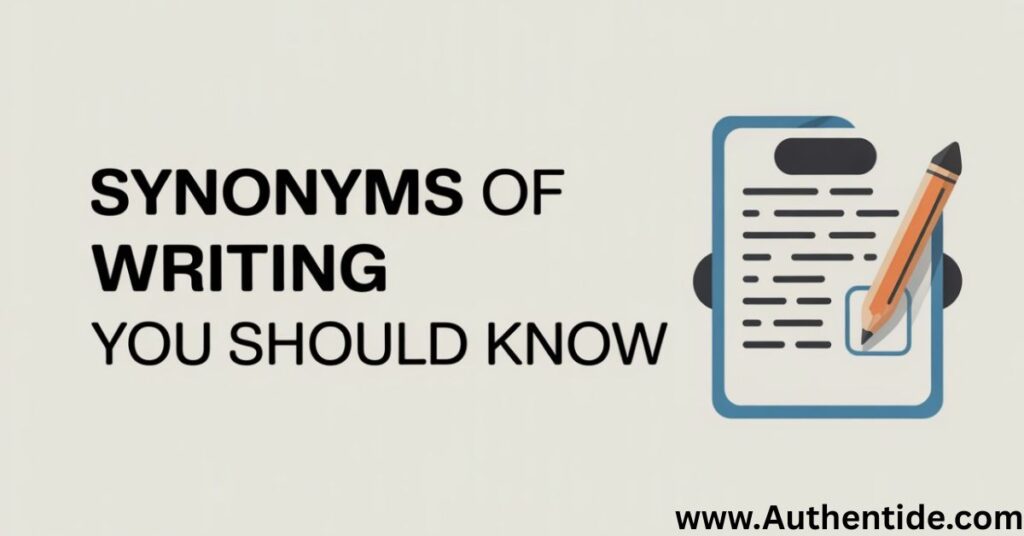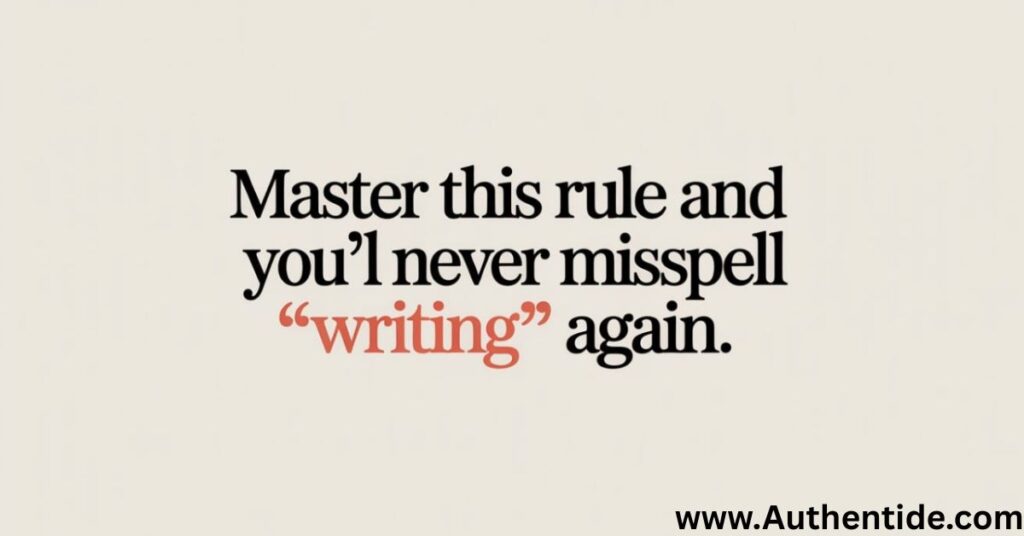Writing is one of those words we use so often, yet some people still pause when they try to spell it. Is it writing or writting? You’ve probably seen both floating around online, in texts, or even emails, and if you’ve ever hesitated mid-sentence, wondering whether to go with one t or two, you’re not alone. The confusion is common, but once you understand a few simple spelling rules, you’ll never second-guess yourself again.
Let’s face it, English spelling rules can be confusing. From silent letters to verb transformations, knowing what to drop, double, or keep can turn writing into a spelling puzzle. But there’s good news: this article will clear things up once and for all. Whether you’re crafting a blog, sending a professional email, or helping your child with homework, you’ll walk away confident in your ability to get it right every time.
Think of this as your go-to guide for correct usage, packed with real-life scenarios, helpful examples, and insights into why “writing” is wrong. And we won’t just stop at spelling, we’ll also explore what writing truly means, how it evolved, and what makes it such a fascinating part of our language.
Correct Spelling: Writing or Writting?
Let’s settle it right now. The correct spelling is writing—with one “t”.
The version with two t’s, writing, is a common spelling mistake, but it’s grammatically incorrect. So, if you’ve ever typed writing in a message, don’t worry, we’ll explain why that extra t doesn’t belong there.
Why “Writing” Is Wrong: Learn the Rule
Understanding the consonant doubling rule in English clears up the confusion.
English uses a rule called the consonant doubling rule to decide whether to double the final consonant before adding the suffix “-ing” to a verb. Here’s the basic idea:
If a verb ends in a single vowel + single consonant, and the final syllable is stressed, double the consonant before adding -ing.
Examples:
- run → running
- sit → sitting
- hit → hitting
But the word write doesn’t follow this pattern.
Why? Because:
- It ends in a silent “e”
- Its final syllable isn’t stressed
So, instead of doubling the t, we drop the silent “e” and simply add -ing:
write → writing
🚫 Wrong: writing
✅ Correct: writing
📧 Email Scenario Example

Incorrect:
Hi Mark,
I am writting a follow-up regarding our project deadline…
Correct:
Hi Mark,
I am writing a follow-up regarding our project deadline…
What “Writing” Actually Means
So what does writing truly mean? It’s more than just putting words on paper. Writing refers to the process of composing, drafting, or documenting ideas using a symbolic system, like letters and punctuation. Whether you’re journaling, penning a novel, or replying to emails, you’re engaging in an essential act of human communication.
It’s the present participle of the verb “write”, and is commonly used to describe ongoing or continuous action.
Spelling Rules That Govern “Writing”
Here are some quick rules that help clarify why “writing” is correct:
| Rule | Explanation | Example |
|---|---|---|
| Drop the Silent “E” | Remove “e” at the end of verbs before adding “-ing” | write → writing |
| Do Not Double | Only double if the verb ends in a single vowel + a single consonant and is stressed | sit → sitting |
| Not Stressed? | If the stress isn’t on the last syllable, don’t double | edit → editing |
These rules form the foundation of English spelling rules, particularly for forming present participles.
Synonyms of Writing You Should Know

If you’re tired of using writing repeatedly, here are a few alternatives depending on the context:
- Composing – when you’re putting together music, documents, or essays
- Drafting – often used for preliminary versions
- Journaling – great for personal diaries
- Penmanship – focuses more on handwriting style
- Note-taking – used in educational or meeting settings
Example:
Instead of saying: “I’m working on my writing today,”
Try: “I’m drafting a short story for the magazine.”
Real-Life Sentences Using “Writing”
Let’s look at the natural usage of the word writing in everyday contexts:
- “Sarah is writing her thesis on climate change policies.”
- “I’ve been writing in my journal every morning to reduce stress.”
- “He’s writing code for a new mobile app.”
These examples show writing as a flexible and dynamic verb that fits into professional, academic, and personal settings.
Where It All Began: The Etymology of Writing
The word writing traces its roots back to the Old English word “writan,” meaning to scratch or draw. Back then, people used sharp tools to carve messages into surfaces—so the original meaning fits perfectly.
Over time, the term evolved, passing through Middle English forms like writen and eventually becoming write in modern usage. The past participle written—with its double “t”—remains as a remnant of older conjugation styles. That’s why it’s written, not written.
It’s fascinating how language carries bits of history within it. Understanding the etymology of writing gives more appreciation for its modern form.
Master This Rule and You’ll Never Misspell “Writing” Again

Here’s the most important part of this article:
If the verb ends in a silent “e,” drop the “e” and add “-ing” without doubling the consonant.
This is the golden rule that explains why we say writing, not writing. It also applies to other verbs:
- make → making
- bake → baking
- create → creating
Memorize this one rule, and not only will you spell writing correctly, but you’ll also fix dozens of other common spelling mistakes. It’s one of the most important English spelling rules you’ll ever need.
Let’s Recap Everything
Here’s a quick refresher:
- ✅ The correct spelling is writing, not writing
- ❌ “Writting” is a spelling mistake and doesn’t follow English spelling rules
- 📚 Follow the consonant doubling rule: only double if the verb ends in a stressed, single vowel + consonant combo
- ✂️ If the verb ends in a silent “e”, drop the silent “e” and just add -ing
- ✏️ “Writing” means drafting, composing, penning, or journaling
- 🧬 The etymology of writing connects it back to early English forms
Final Thoughts
From emails and essays to novels and notes, writing is a skill you use daily. Whether you’re helping a student learn spelling, preparing a job application, or simply trying to avoid an embarrassing typo in your next LinkedIn post, knowing that it’s writing—with one t—will keep you confident and polished.
So next time your fingers hover over the keyboard, wondering “writing or writing?”, remember this article, and trust your instincts—you’ve got it right.

Your go-to place for smart synonyms and celebrity updates. Muhammad Hassan Abid is dedicated to creating useful, engaging content that informs, inspires, and truly serves your curiosity

